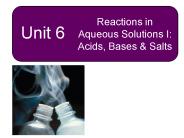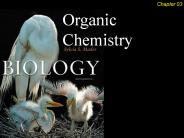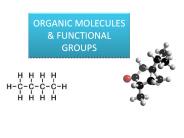Organic Acid Reactions PowerPoint PPT Presentations
All Time
Recommended
Organic Reactions Combustion Substitution Addition Esterification Saponification Fermentation Polymerization Reactions 2. Condensation Polymerization: monomers ...
| PowerPoint PPT presentation | free to download
Whenever we cook food, we are acting as organic chemists. The proteins, fats, and carbohydrates that make up our food are organic compounds, and cooking the food ...
| PowerPoint PPT presentation | free to view
Organic Reactions
| PowerPoint PPT presentation | free to download
Intro to Organic Reactions Polystyrene Polystyrene is nonpolar material and dissolves in organic solvents. PS foam is mostly air, and when it dissolves it collapses ...
| PowerPoint PPT presentation | free to view
Isomers and Organic Reactions 10 Points Extra Credit: Due Friday Choose a product that is in your home (i.e., shampoo, lotion, etc.) and find the chemical structures ...
| PowerPoint PPT presentation | free to download
Level 3: Organic Reactions Part I Aldehydes Ketones Haloalkanes Amines Aldehydes - Introduction Aldehydes are very similar to carboxylic acids in structure (but they ...
| PowerPoint PPT presentation | free to download
An electrophile is a molecule or ion that is attracted to electron-rich regions ... An electrophilic addition reaction is an addition reaction which happens because ...
| PowerPoint PPT presentation | free to view
Chapter Fifteen Acids, Bases, and Acid Base Equilibria The Br nsted Lowry Theory Arrhenius theory: an acid forms H+ in water; and a base forms OH in water.
| PowerPoint PPT presentation | free to download
At Myreen Young, we have created a range of superb organic face masque and organic face peel products to suit different skin types and needs. Whether you have dry and dull-looking skin, blemished congested skin or sensitive and dehydrated skin, we have a product to suit you which will help you to maintain a healthy glow. Formulated with 100% natural ingredients and with no parabens, artificial fragrances or unnecessary chemicals, our organic face peel and organic face masque products can be combined with our natural cleansers, organic face cream and other products to give you a complete beauty regime. Simply use two or three times a week after cleansing and follow with a day or night cream to give your skin a refreshing and brightening boost.
| PowerPoint PPT presentation | free to download
An Introduction to Organic Reactions and Their Mechanism Acids and Bases 3.4 Acid Strength Strong acids: completely ionized or completely dissociated Forward reaction ...
| PowerPoint PPT presentation | free to download
Reactions in Aqueous Solutions I: Acids, Bases & Salts * Acid-Base Reactions in Aqueous Solutions There are four acid-base reaction combinations that are possible ...
| PowerPoint PPT presentation | free to download
Chpt. 23: Types of Reactions In Organic Chemistry C H H C H H H O H A double bond is formed between the carbons Ethene an unsaturated compound is formed + The ...
| PowerPoint PPT presentation | free to download
But not all acid base reactions involve water, and many bases (NH3, carbonates) ... on the ring further diminish the basicity of aromatic amines relative to aniline. ...
| PowerPoint PPT presentation | free to view
Chapter 8: Organic Acids and Bases Acid/Base Reactions Some organic chemicals have exchangeable protons (acids) or lone pair electrons which can accept hydrogen ...
| PowerPoint PPT presentation | free to view
Lentikats Biotechnology LENTIKATS BIOTECHNOLOGY FOR LACTIC ACID PRODUCTION Producer: bacteria Bacillus coagulans. Substrates: glucose, sucrose, lactose.
| PowerPoint PPT presentation | free to download
Chapter Fifteen Acids, Bases, and Acid Base Equilibria The Br nsted Lowry Theory Arrhenius theory: an acid forms H+ in water; and a base forms OH in water.
| PowerPoint PPT presentation | free to view
Based on McMurry s Organic Chemistry, 7th edition * Mechanism of Ester Hydrolysis Hydroxide ... Substitution in Synthesis General Reactions of ...
| PowerPoint PPT presentation | free to download
example on top of page 791. Oxidation- Reduction Reactions ... Methane can be oxidized in steps to carbon dioxide (top page 792) ... Equations top of page 793 ...
| PowerPoint PPT presentation | free to view
However, a carbocation forms .! But aren t carbocations UNSTABLE ? ... The negative ion then attacks the carbocation minor How about this reaction .?
| PowerPoint PPT presentation | free to view
Bharat Book Bureau provides the report on “Global Organic Acid Market 2012-2026”, (https://www.bharatbook.com/materials-chemicals-market-research-reports-860503/global-organic-acid-acetic-acid-citric-acid-formic-acid-lactic-acid.html)The report provides the size of organic acid market, in terms of volume, with respect to key end use industries.
| PowerPoint PPT presentation | free to download
Title: Organic Chemistry 1 An introductory course in organic chemistry for CM1000, CM1002, CM2101 and related modules Author: Humphrey Moynihan Last modified by
| PowerPoint PPT presentation | free to download
CHE 242 Unit VIII The Structure, Properties, Reactions and Mechanisms of Carboxylic Acids and Their Derivatives CHAPTER TWENTY-ONE Terrence P. Sherlock
| PowerPoint PPT presentation | free to download
Recyclable Organomolybdenum Lewis Acid Catalyst and Microwave Assisted Pechmann ... participation of specific effects in some microwave-assisted organic synthesis.
| PowerPoint PPT presentation | free to download
The Citric Acid Cycle, Krebs Cycle, Three Carboyxlic Acid Cycle
| PowerPoint PPT presentation | free to view
The importance of soil organisms and the roles they play in ... Aerobes: Azotobacter, A. beijerinckia, (hetero) Anaerobes: Clostridium, (most common) ...
| PowerPoint PPT presentation | free to view
Chapter 6: Reactions of Alkenes: Addition Reactions
| PowerPoint PPT presentation | free to view
General form: XY (aq) AB (aq) XB (aq) AY (s) Tip off: XY and AB are both salts ... Exercise in completing reactions & getting net ionic reactions (NIE) ...
| PowerPoint PPT presentation | free to view
Substitution reactions: a functional group replaces a hydrogen atom ... Nylon is the name for a group of polyamide fibers. Nylon-66 can be made from adipic ...
| PowerPoint PPT presentation | free to view
Unit 7 - Organic Molecules II Carboxylic Acids, Phenols & Amines In this unit and the next we look at the chemical and physical properties of a variety of organic ...
| PowerPoint PPT presentation | free to download
Surface Chemistry of propionic acid and pyruvic acid on Ni(100) Xiang Yang Department of Chemistry University of Waterloo, Waterloo, Ontario, Canada
| PowerPoint PPT presentation | free to download
Nitrogen fixation and assimilation, amino acid degradation, the urea cycle ... The urea cycle uses nitrogen from NH4 and the amino acid aspartate to generate ...
| PowerPoint PPT presentation | free to view
ORGANIC COMPOUNDS What Builds This Object? Macromolecules Building of Cells Carbohydrates Lipids Proteins Nucleic Acids What Builds These Macromolecules?
| PowerPoint PPT presentation | free to view
Chemistry William H. Brown & Christopher S. Foote The Organic Chemistry of Metabolism Introduction We have now studied the typical reactions of the major classes of ...
| PowerPoint PPT presentation | free to download
Malonic acid, also called propanedioic acid, is a precursor to specialty polyesters. It is a dibasic organic acid whose diethyl ester is used in syntheses of vitamins B1 and B6, barbiturates, and numerous other valuable compounds. Malonic acid itself is rather unstable and has few applications. Its calcium salt occurs in beetroot, but the acid itself is usually prepared by hydrolyzing diethyl malonate. It undergoes the usual reactions of carboxylic acids as well as facile cleavage into acetic acid and carbon dioxide.
| PowerPoint PPT presentation | free to download
Organic Chemistry William H. Brown & Christopher S. Foote ...
| PowerPoint PPT presentation | free to download
Organic Chemistry 6th Edition Paula Yurkanis Bruice Chapter 16 Reactions of Substituted Benzenes *
| PowerPoint PPT presentation | free to download
Acids & Bases Properties of Acids Sour taste Change color of acid-base indicators (red in pH paper) Some react with active metals to produce hydrogen gas Ba(s ...
| PowerPoint PPT presentation | free to download
Polar, acidic; some amino acids. Example: Adenosine triphosphate ... Each amino acid has a central carbon atom (the alpha carbon) to which are attached ...
| PowerPoint PPT presentation | free to download
Get a sample brochure @ http://tinyurl.com/jkfceyz Citric acid (2-hydroxypropane-l, 2, 3, tricarboxylic acid) is amongst the most important organic acid produced in tonnage by fermentation. It is a primary metabolic product and is formed due to a series of chemical reactions that unifies carbohydrate, fat, and protein metabolism. It is one of the most indispensable and widely used organic acids which occur naturally in various citrus fruits as well as animal fluids and tissues. It is a weak acid and is highly miscible in nature.
| PowerPoint PPT presentation | free to download
Examples Examples Functional group Naming As with other organic molecules, except ending is anoic acid. Reactions React with alkanols to produce esters.
| PowerPoint PPT presentation | free to download
In the world of chemistry, there are numerous reagents and compounds that play vital roles in various chemical reactions. Chlorosulfonic Acid 98% for Chemical Reactions concentration, is one such powerful reagent that finds applications in a wide range of chemical processes.
| PowerPoint PPT presentation | free to download
Organics Non-Hydrocarbons Haloalkanes uses and sources Alcohols uses, sources and reactions Carboxylic acids uses, sources and reactions
| PowerPoint PPT presentation | free to view
Amines and Amides Amines are organic bases and amides are the products of a condensation reaction between an amine and a carboxylic acid http://z.about.com/d ...
| PowerPoint PPT presentation | free to download
William H. Brown & Christopher S. Foote Organic Polymer Chemistry Chapter 24 Organic Polymer Chem. Polymer: from the Greek, poly + meros, many parts any long-chain ...
| PowerPoint PPT presentation | free to download
PowerPoint Presentation ... VII. Organic
| PowerPoint PPT presentation | free to view
Organic Chemistry William H. Brown & Christopher S. Foote
| PowerPoint PPT presentation | free to view
Organic Chemistry 6th Edition Paula Yurkanis Bruice Chapter 7 Delocalized Electrons and Their Effect on Stability, Reactivity, and pKa More About Molecular
| PowerPoint PPT presentation | free to view
organic molecules & functional groups
| PowerPoint PPT presentation | free to download
Organic Compounds Found in all living things contain carbon and stored energy
| PowerPoint PPT presentation | free to view
Organic Compounds of ... Humans also take in ... These exceptions plus the compounds of the remaining elements are considered to inorganic Organic Compounds ...
| PowerPoint PPT presentation | free to view
William H. Brown & Christopher S. Foote Br nsted-Lowry Definitions Acid: a proton donor Base: a proton acceptor Conjugate Acids & bases Conjugate base: the species ...
| PowerPoint PPT presentation | free to download
Unit 10 Organic Chemistry
| PowerPoint PPT presentation | free to download
... Unsaturated some are solid but most are liquid at RT/BT Fatty Acids Saturated fatty acid each carbon in the hydrocarbon chain is saturated with hydrogen no ...
| PowerPoint PPT presentation | free to view
Organic Mechanisms Chapter 23
| PowerPoint PPT presentation | free to download
Organic Chemistry Chapter 22-23
| PowerPoint PPT presentation | free to download
VII. Organic Organic compounds contain carbon atoms which bond to one another in chains, rings, and networks to form a variety of structures. Organic compounds can be ...
| PowerPoint PPT presentation | free to view
























































